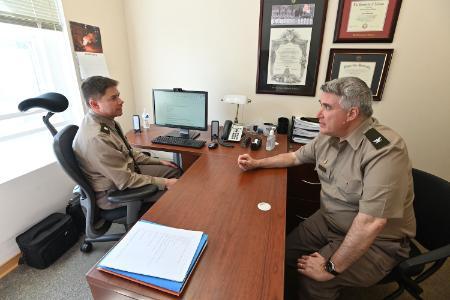VMI Psychologists Research Veteran Suicide Prevention

Maj. Michael LaRocca and Col. Glenn Sullivan discuss their research on veteran suicide prevention. –VMI Photo by Kelly Nye.
LEXINGTON, Va. Feb. 16, 2025 — According to the Centers for Disease Control and Prevention, nearly 50,000 Americans die by suicide each year and about 20% of those decedents are military veterans. Col. Glenn Sullivan, associate professor, and Maj. Michael LaRocca, assistant professor in the Department of Psychology at Virginia Military Institute, are extremely concerned with those statistics, and have received a $150,000 grant from the Virginia Department of Veterans Services to conduct research on veteran suicide prevention.
According to Sullivan and LaRocca, a wide range of risk factors have already been identified that contribute to the suicide rate for veterans. The two VMI psychologists chose to investigate four factors that have not received adequate attention from researchers. The four include the quality of leadership while on active duty; lack of access or substandard mental health care, or feeling pressured not to seek mental health care while on active duty; post-military occupational history; and exposure to suicide either while on active duty or among one’s circle of veteran acquaintances.
LaRocca explained their research method.
“We created a survey using Qualtrics, a web based software used by many social and behavioral scientists, and reached out to veterans, and clinicians working with veterans through social media, informing them of our research and asking the veterans to participate. The response was incredible. We have data from 250 participants, from all branches of the military, including a good representative sample of female veterans. Most of them were enlisted personnel who served between four to six years, and are relatively recent veterans, with an average of 10 years of civilian life behind them.”
Sullivan, lead principal investigator, and LaRocca, co-lead principal investigator, come at the same subject from different perspectives. LaRocca, an Army combat veteran himself, is studying the leadership the veterans received while in the military and how it affected them psychologically during their time in the service, as well as after they were discharged, and years beyond.
“In my experiences in the Army, and before that as a cadet at West Point, I was always struck by how impactful leaders are. Leaders who are positive and supportive can have a very protective effect on service members and maintain good morale. On the other side of that coin, leaders who are less supportive really miss opportunities to provide encouragement to their followers. Service members go through major stressors, particularly if they deploy, and quality leadership can be a buffer against stressors. My unit in Iraq experienced loss and psychological distress. That stuck with me and was part of the reason I became interested in psychology. I try to draw from my background as a combat veteran to help others overcome their distress.”
LaRocca teaches leadership to VMI cadets, many of whom will be military officers.
“I try to hammer home in my classes that leaders really do make or break situations, and that effective leadership is more than just the short-term success of accomplishing a mission. It has a psychological impact. No matter how long veterans have been out of the military, they remember their leaders. In particular, they remember how strongly their leaders impacted them, whether positively or negatively. Leaders don’t need to be psychologists, but they can be psychologically informed and do things like teaching, coaching, mentoring, and encouraging their followers to ask for help.”
Sullivan’s scope of the research includes post-military occupational history, lack of access to mental health care, and exposure to the suicide of others. He explained that regarding vocation, people who are at most risk are those who work with their hands.
“In our survey we asked the veterans what they did in the military. Were they in one of the military specialties, like the infantry or Calvary Scout, in which they ended up after four years with some bad joints, bad knees, and back pain? Skills learned in the military don’t always transfer to the civilian marketplace, so many veterans end up working in construction or other manual labor, which is even worse for joints and backs. Perhaps they were treated with opioid pain medication, and we know that chronic pain and opioid pain medication use are risk factors for suicide.”
Sullivan stated that often veterans may deny being suicidal, yet have many risk factors.
“The overarching goal of our research is to help clinicians and hospitals who work with vets, and organizations like the Veterans Administration to better reach people who need them but aren’t seeking their help. One reason veterans may not seek help is that the VA is only open during normal business hours when most people need to be at work. A simple thing like having evening and weekend hours would help significantly.”
Col. James Gire, head of the Department of Psychology, is pleased to see members of his faculty seizing opportunities like this grant-supported project.
“Colonel Sullivan and Major LaRocca each add unique perspectives that make their collaboration greater than the sum of its parts. I think that their research will have a positive impact on the mental health of veterans, and that the cadets in their classes will be fascinated by their findings,” said Gire.
Though their data collection is complete, LaRocca and Sullivan continue to analyze the information. They plan to present their findings to conferences, the first one scheduled for March at the Society for Personality Assessment conference in Denver. They hope to publish their research in peer-reviewed journals.
Marianne Hause
Communications & Marketing
VIRGINIA MILITARY INSTITUTE
.svg)
.png)